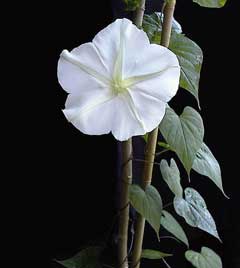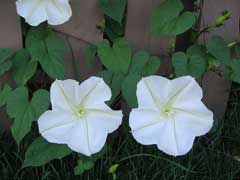 |
|
http://commons.wikimedia.org/wiki/User:Epibase |
 |
| http://en.wikipedia.org/wiki/User:Ed! |
Translate this page:
Summary
Physical Characteristics

 Ipomoea is an evergreen Perennial Climber growing to 10 m (32ft 10in) at a fast rate.
Ipomoea is an evergreen Perennial Climber growing to 10 m (32ft 10in) at a fast rate.
See above for USDA hardiness. It is hardy to UK zone 8. It is in leaf all year, in flower from July to August. The species is hermaphrodite (has both male and female organs).
Suitable for: light (sandy) and medium (loamy) soils and prefers well-drained soil. Suitable pH: mildly acid, neutral and basic (mildly alkaline) soils. It cannot grow in the shade. It prefers moist soil.
UK Hardiness Map
US Hardiness Map
Synonyms
Calonyction aculeatum. C. album.
Plant Habitats
Edible Uses
Young leaves and fleshy calyces - cooked. Steamed and eaten as a vegetable or used in curries, soups, stews etc[183]. They can also be dried for later use[183]. Seed - eaten when young[183].
References More on Edible Uses
Medicinal Uses
Plants For A Future can not take any responsibility for any adverse effects from the use of plants. Always seek advice from a professional before using a plant medicinally.
The whole herb is used in treating snakebite[266].
References More on Medicinal Uses
The Bookshop: Edible Plant Books
Our Latest books on Perennial Plants For Food Forests and Permaculture Gardens in paperback or digital formats.

Edible Tropical Plants
Food Forest Plants for Hotter Conditions: 250+ Plants For Tropical Food Forests & Permaculture Gardens.
More

Edible Temperate Plants
Plants for Your Food Forest: 500 Plants for Temperate Food Forests & Permaculture Gardens.
More

More Books
PFAF have eight books available in paperback and digital formats. Browse the shop for more information.
Shop Now
Other Uses
References More on Other Uses
Cultivation details
Requires a fertile well-drained loam in a warm sunny position[200]. This species is not hardy in the colder areas of the country, it tolerates temperatures down to between -5 and -10°c[200]. Another report says that plants need a minimum temperature of 5°c if they are to overwinter successfully[260]. A short-lived perennial or biennial species[187]. A fast-growing climbing plant, it is best grown as a temporary screen in the garden or along the boundary edge[200]. Plants need a long period of growth to reach flowering size and so are not very suitable for growing in pots in a greenhouse[260]. A climbing plant, supporting itself by twining around the branches of other plants[219]. The plant forms tubercles (baby tubers) on the stems and can be propagated by them[260]. The aromatic flowers open of a night time[188].
References Carbon Farming Information and Carbon Sequestration Information
Temperature Converter
Type a value in the Celsius field to convert the value to Fahrenheit:
Fahrenheit:
The PFAF Bookshop
Plants For A Future have a number of books available in paperback and digital form. Book titles include Edible Plants, Edible Perennials, Edible Trees,Edible Shrubs, Woodland Gardening, and Temperate Food Forest Plants. Our new book is Food Forest Plants For Hotter Conditions (Tropical and Sub-Tropical).
Shop Now
Plant Propagation
Pre-soak the seed for 12 hours in warm water, or scarify the seed, and sow in individual pots in a greenhouse in early spring. The seed usually germinates in 1 - 3 weeks at 22°c. Plants are extremely resentful of root disturbance, even when they are quite small, and should be potted up almost as soon as they germinate[219]. Grow them on in the greenhouse for at least their first winter then plant them out into their permanent positions in late spring or early summer, after the last expected frosts. Cuttings of side shoots in a peaty soil. Layering. Plants form tubercles on their stems[260]. These can be stored overwinter in a slightly moist medium such as sand or leafmould, keeping them in a cool but frost-free place. Pot them up in early spring.
Other Names
If available other names are mentioned here
Native Range
NORTHERN AMERICA: United States (Florida), Mexico (Baja California Sur, San Luis Potosí, Sinaloa, Sonora, Tamaulipas, Campeche, Chiapas, Colima, Guanajuato, Guerrero, Hidalgo, Jalisco, México, Michoacán de Ocampo, Morelos, Nayarit, Oaxaca, Puebla, Querétaro, Quintana Roo, Tabasco, Veracruz de Ignacio de la Llave, Yucatán) SOUTHERN AMERICA: Bahamas, Cuba, Dominican Republic, Haiti, Belize, Costa Rica, Guatemala, Honduras, Nicaragua, Panama, French Guiana, Guyana, Suriname, Venezuela, Brazil, Bolivia, Colombia, Argentina
Weed Potential
Right plant wrong place. We are currently updating this section.
Please note that a plant may be invasive in one area but may not in your area so it’s worth checking.
Conservation Status
IUCN Red List of Threatened Plants Status :

Growth: S = slow M = medium F = fast. Soil: L = light (sandy) M = medium H = heavy (clay). pH: A = acid N = neutral B = basic (alkaline). Shade: F = full shade S = semi-shade N = no shade. Moisture: D = dry M = Moist We = wet Wa = water.
Expert comment
Author
L.
Botanical References
200266
Links / References
For a list of references used on this page please go here
Readers comment
| Add a comment |
|
If you have important information about this plant that may help other users please add a comment or link below. Only comments or links that are felt to be directly relevant to a plant will be included. If you think a comment/link or information contained on this page is inaccurate or misleading we would welcome your feedback at [email protected]. If you have questions about a plant please use the Forum on this website as we do not have the resources to answer questions ourselves.
* Please note: the comments by website users are not necessarily those held by PFAF and may give misleading or inaccurate information.
To leave a comment please Register or login here All comments need to be approved so will not appear immediately.
|
|